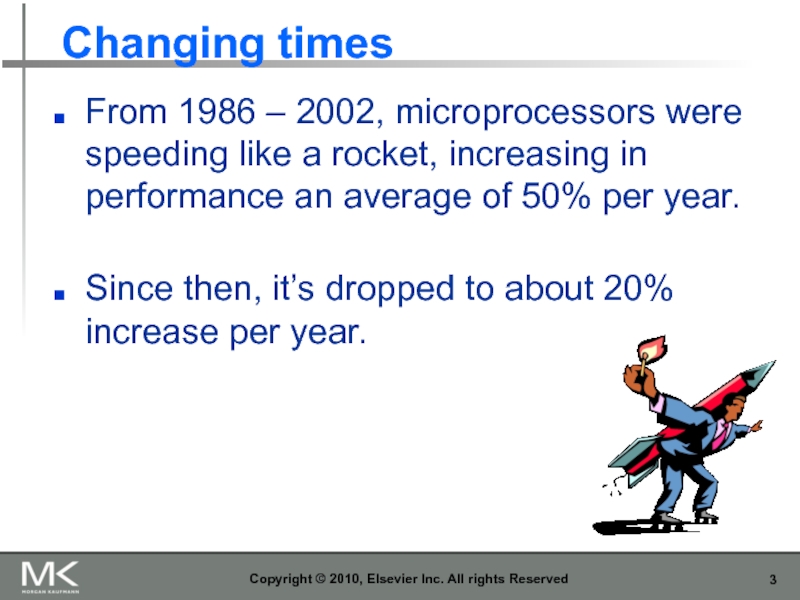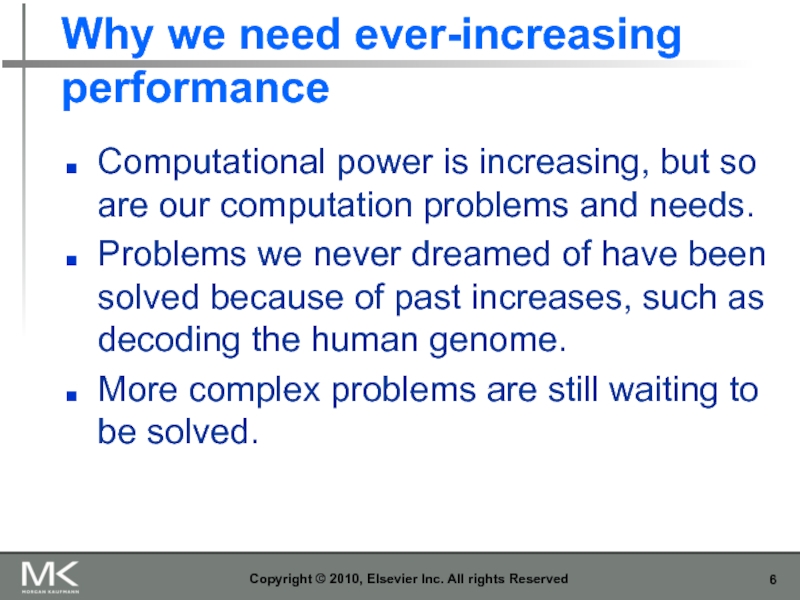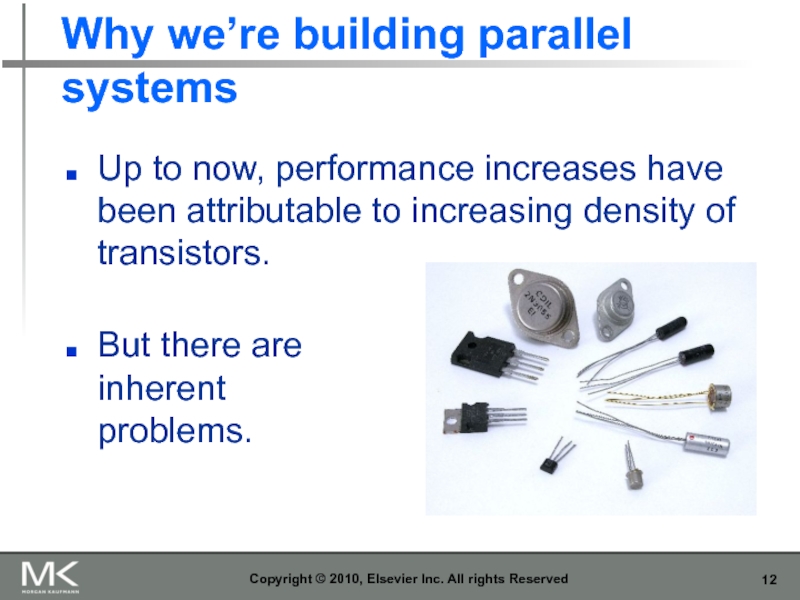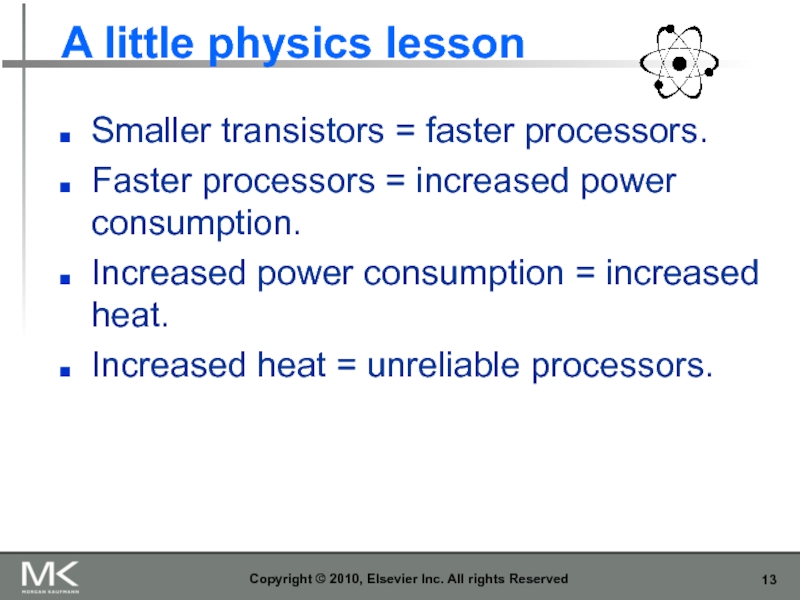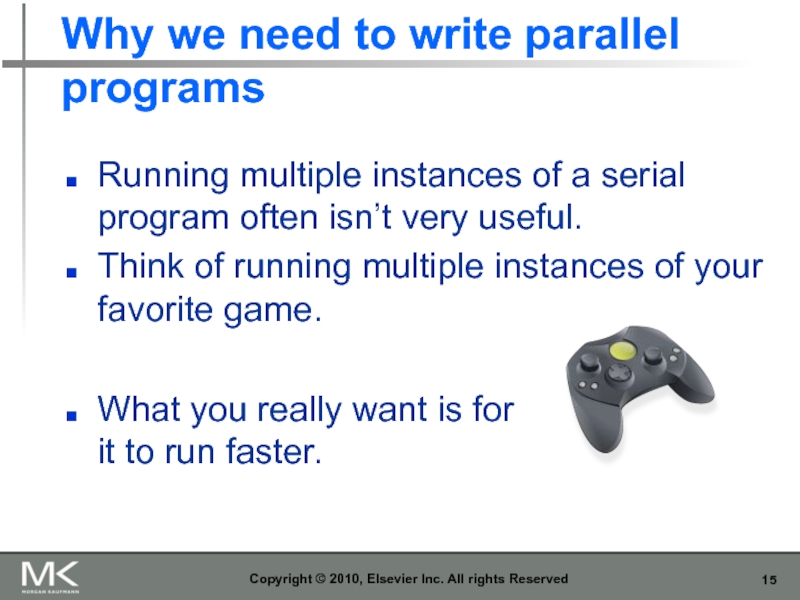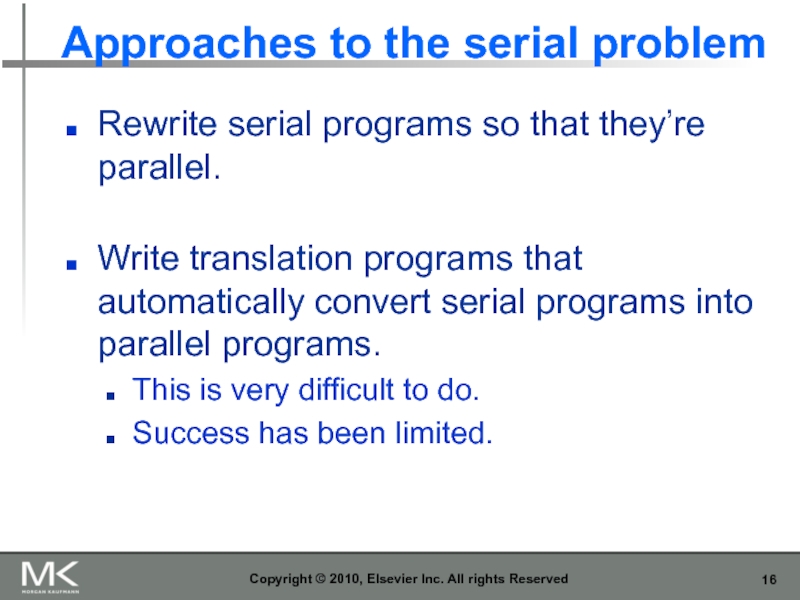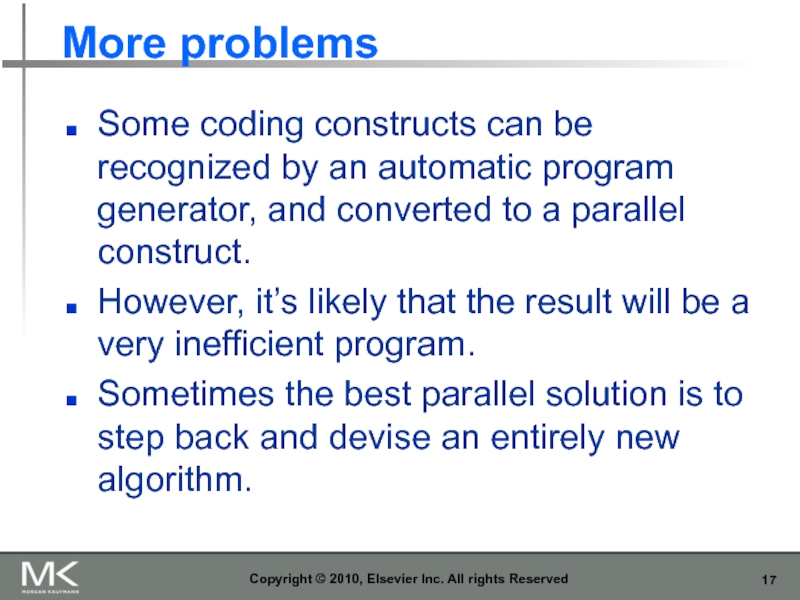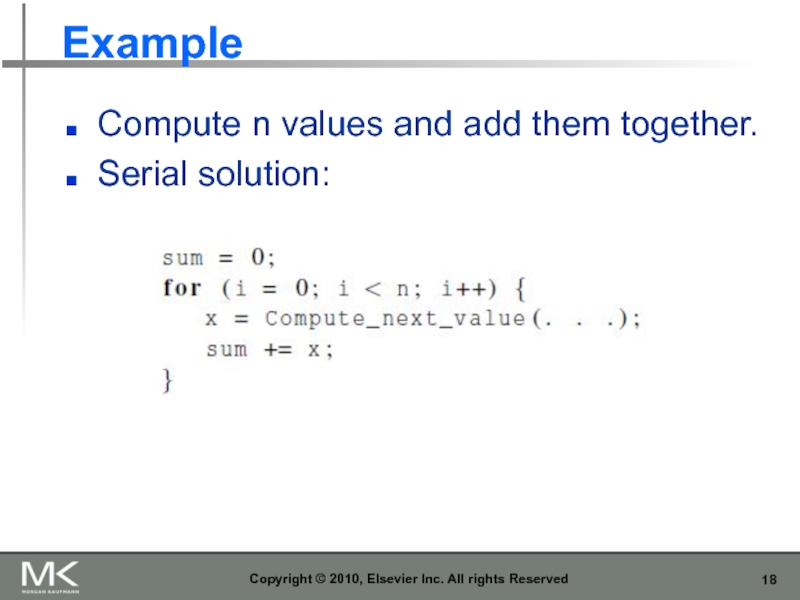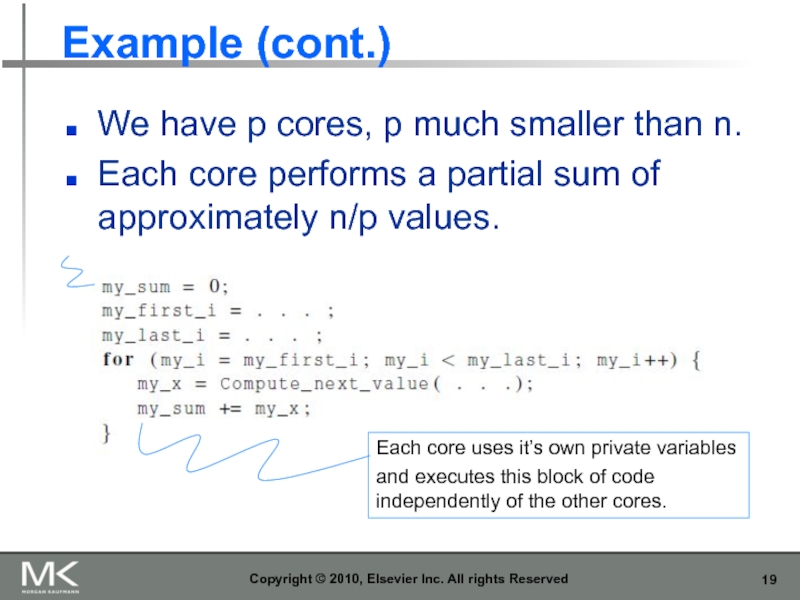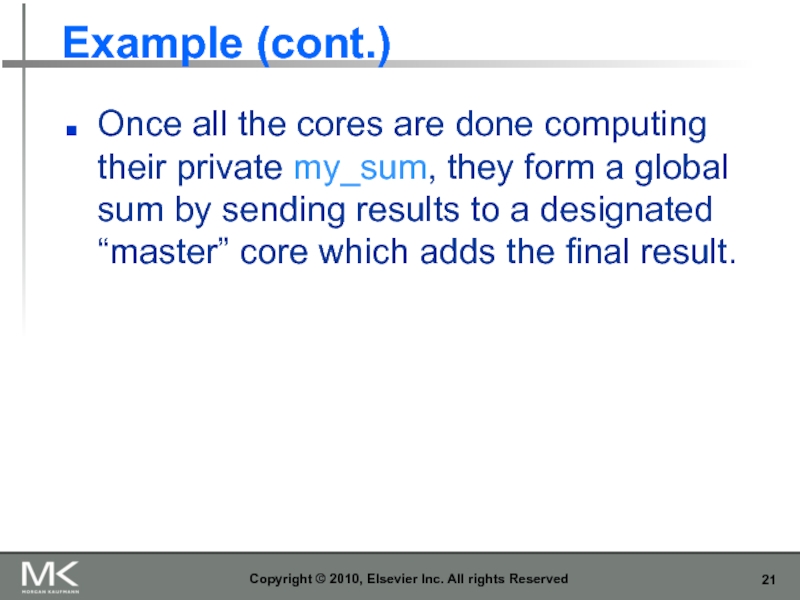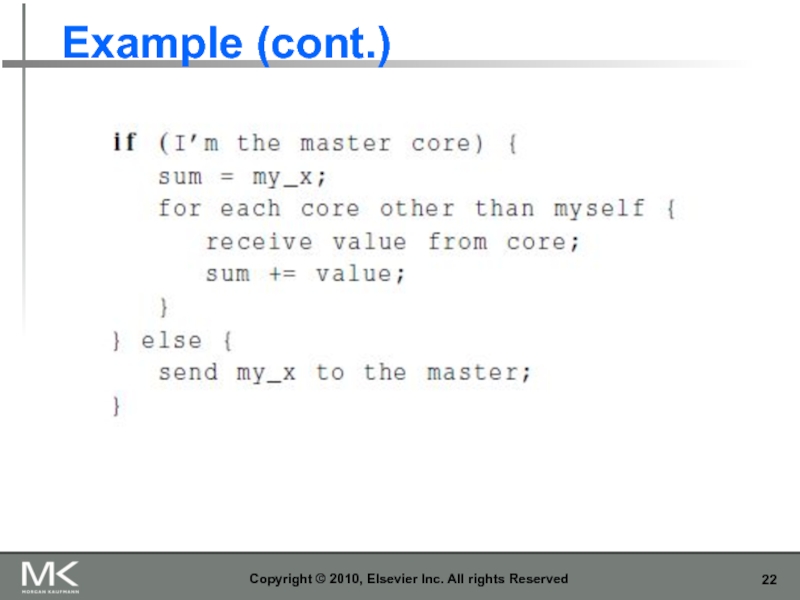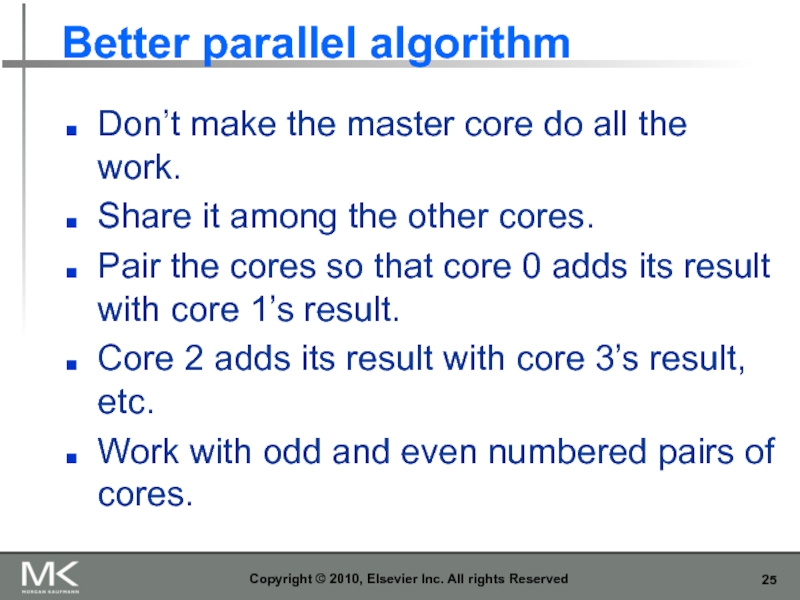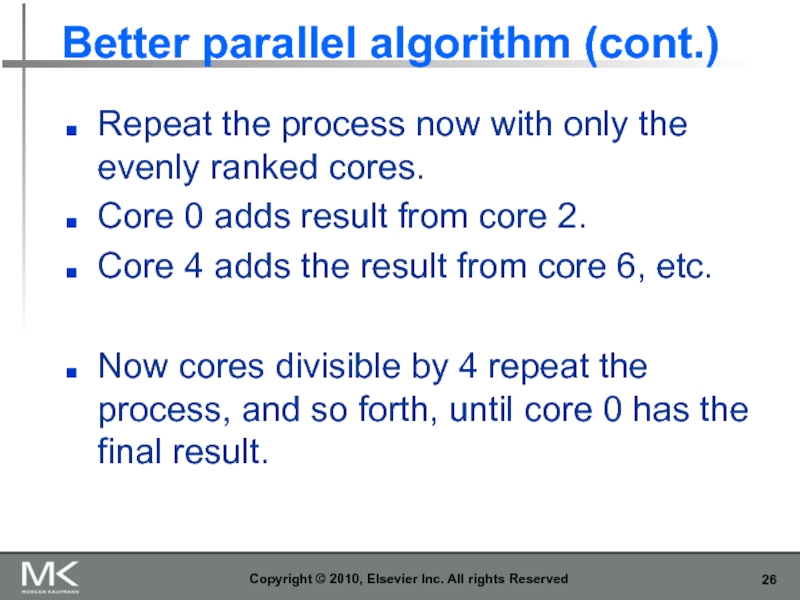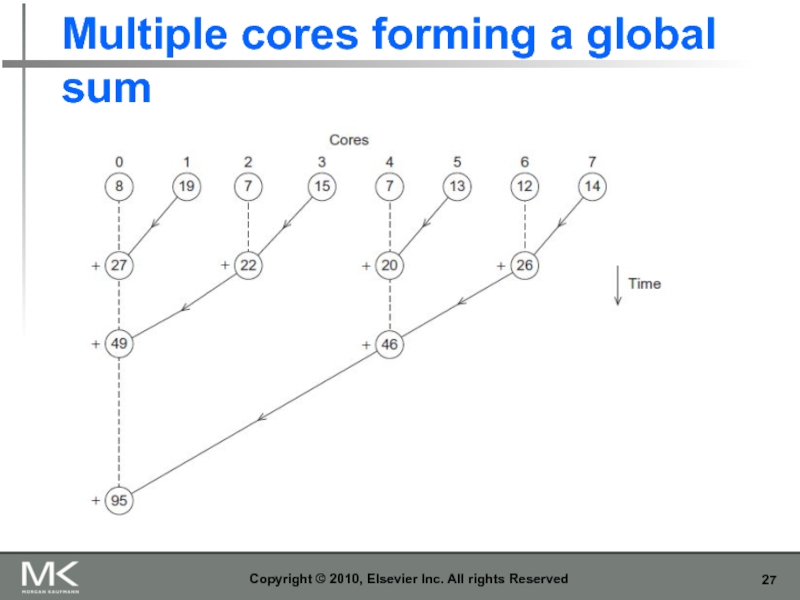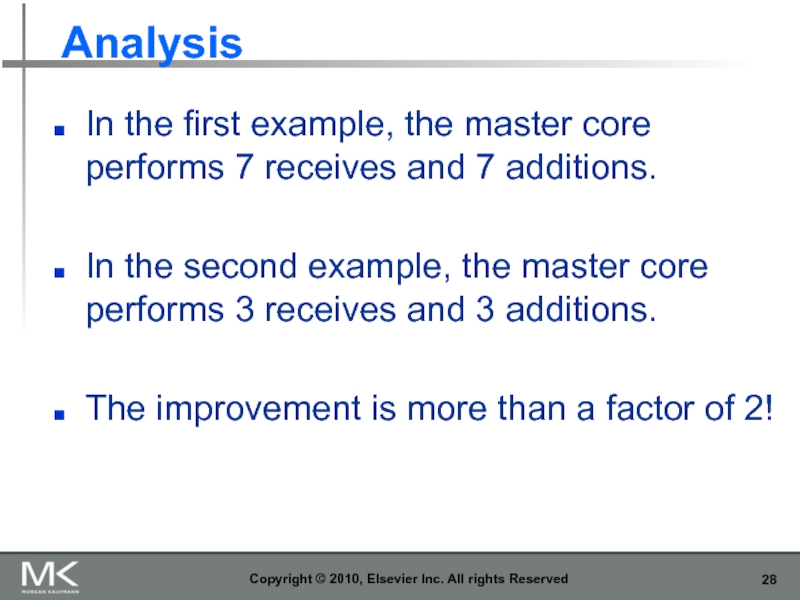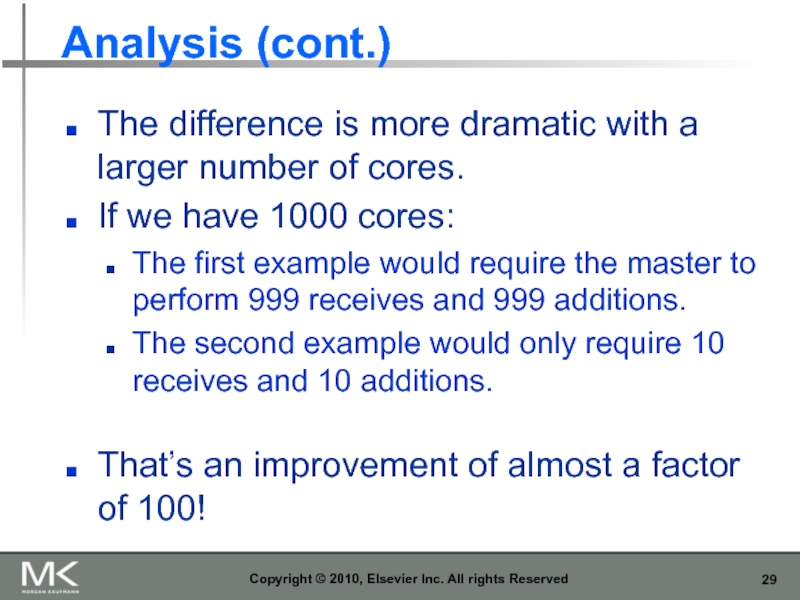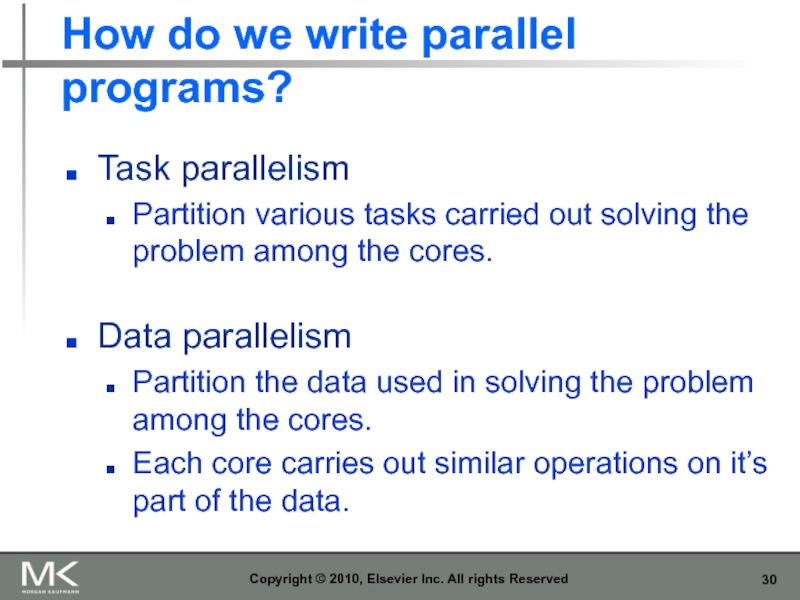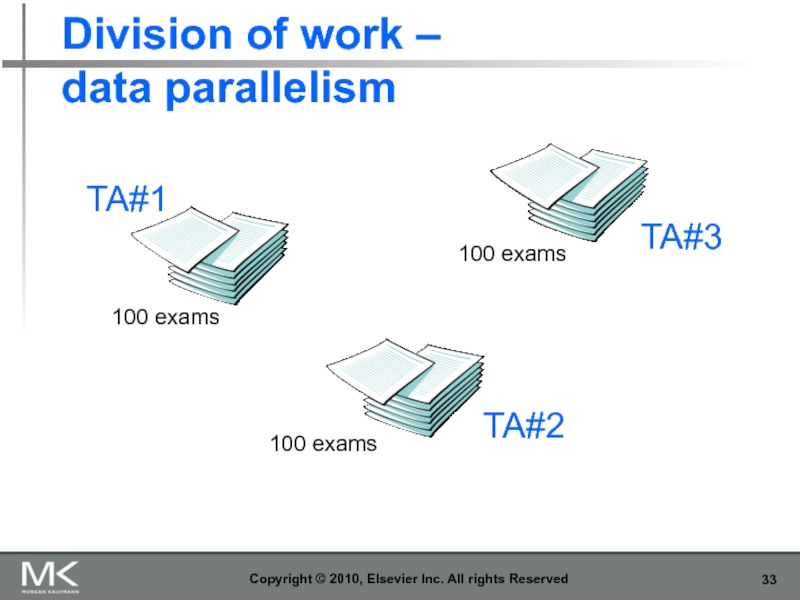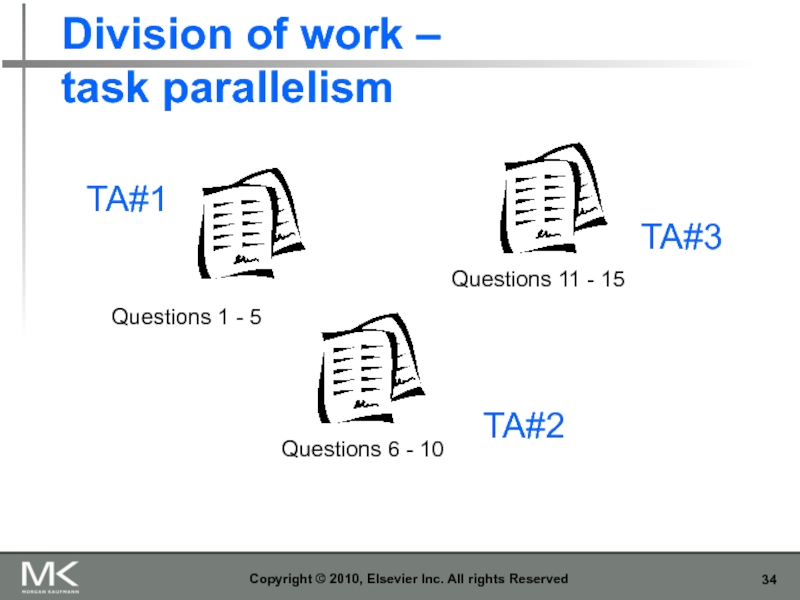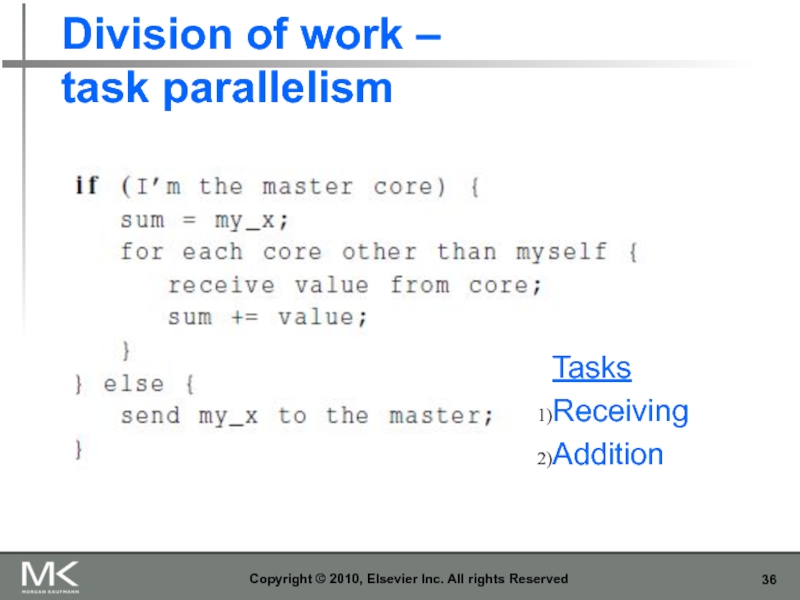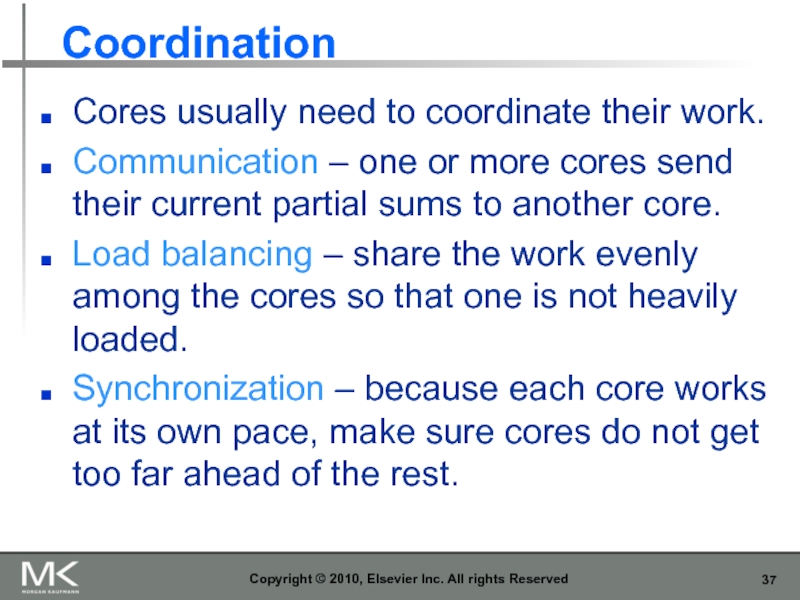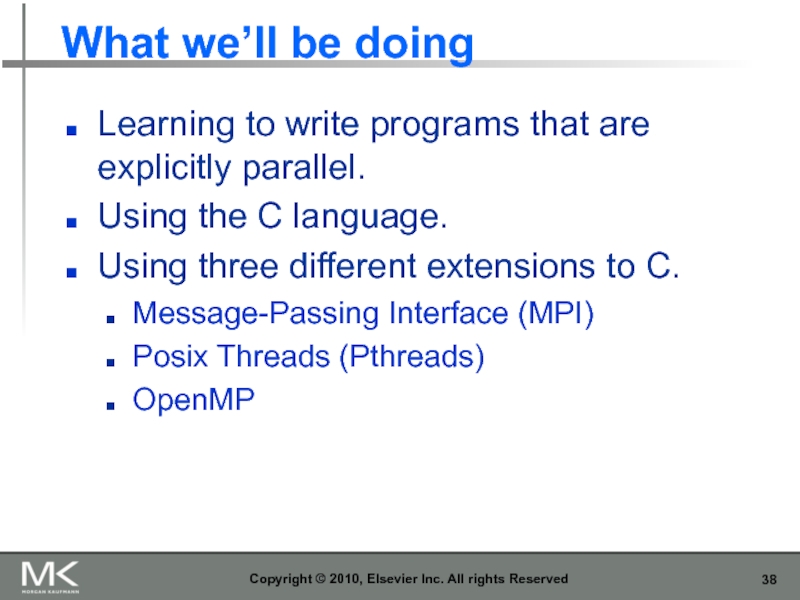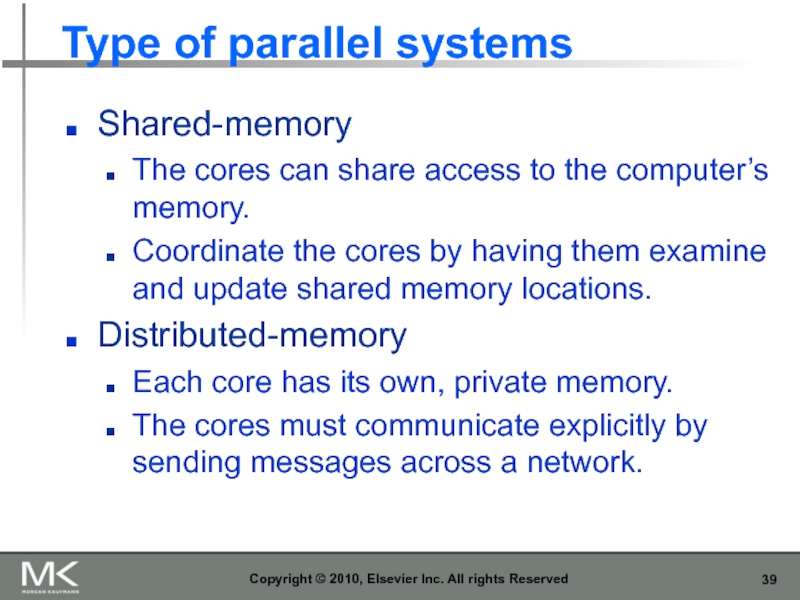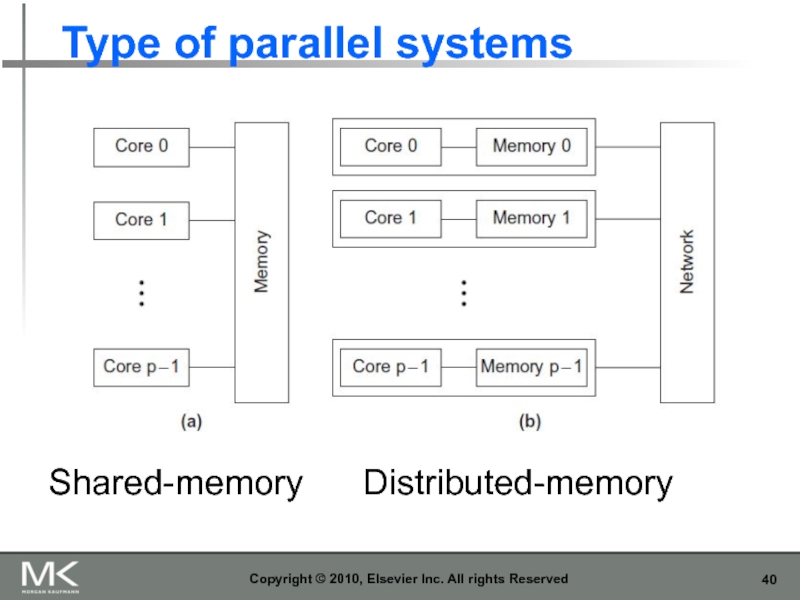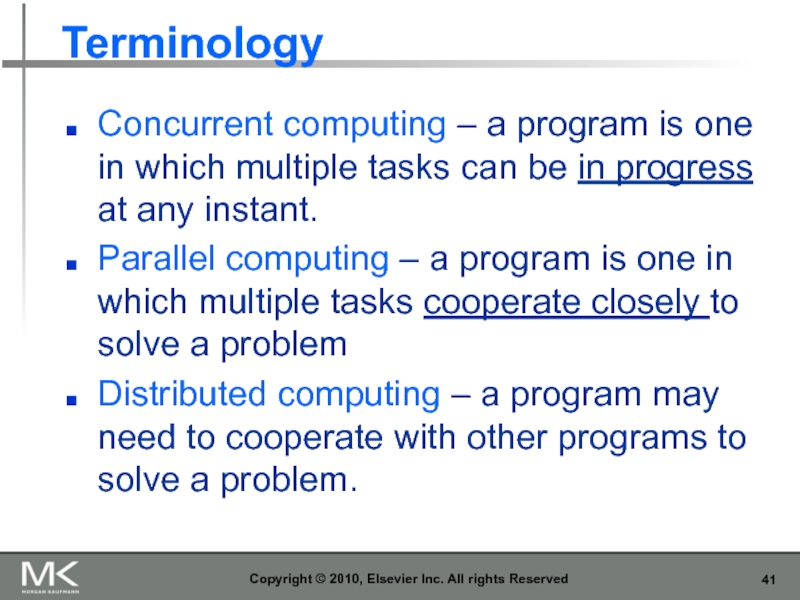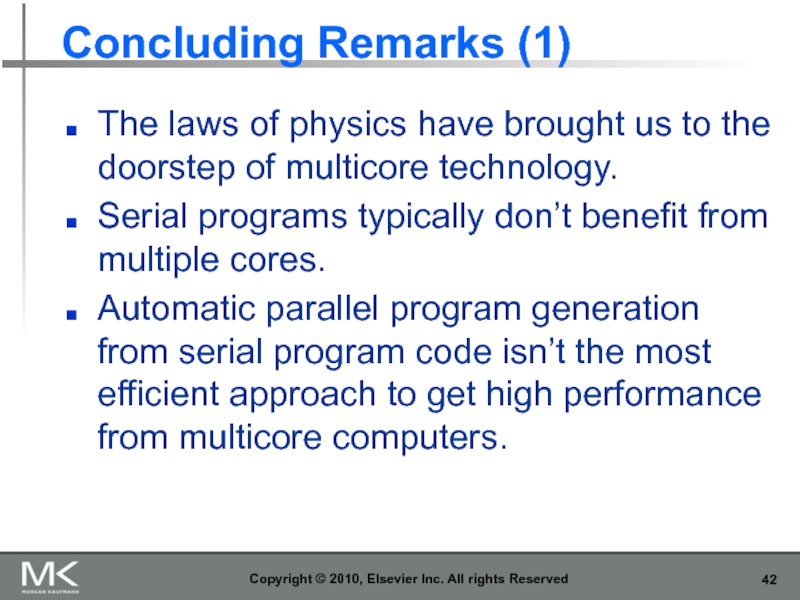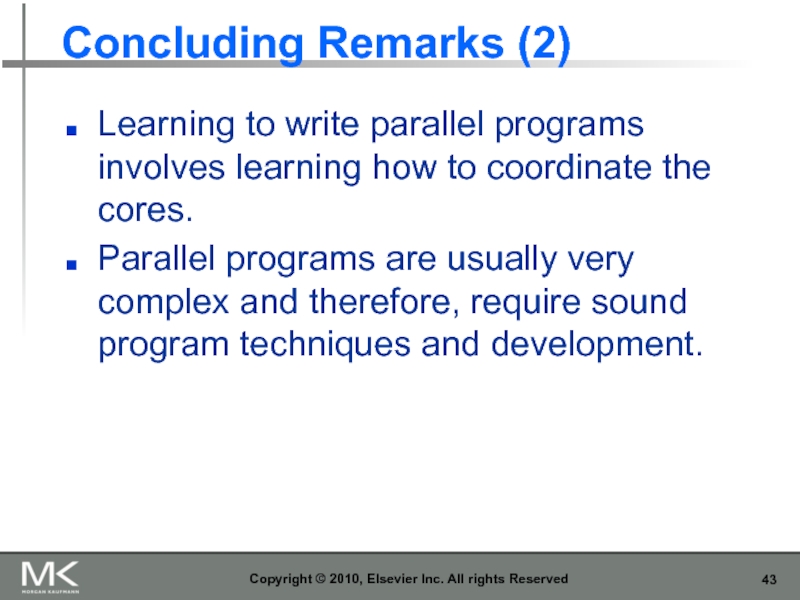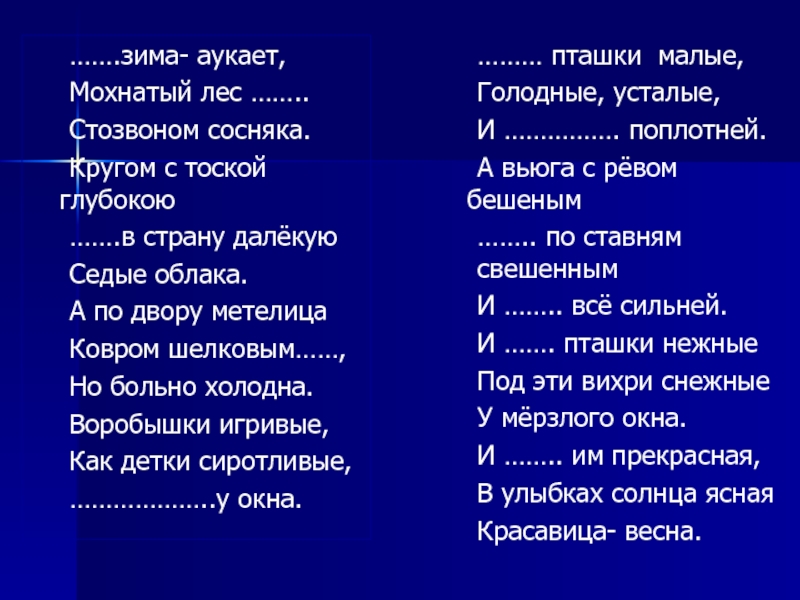- Главная
- Разное
- Дизайн
- Бизнес и предпринимательство
- Аналитика
- Образование
- Развлечения
- Красота и здоровье
- Финансы
- Государство
- Путешествия
- Спорт
- Недвижимость
- Армия
- Графика
- Культурология
- Еда и кулинария
- Лингвистика
- Английский язык
- Астрономия
- Алгебра
- Биология
- География
- Детские презентации
- Информатика
- История
- Литература
- Маркетинг
- Математика
- Медицина
- Менеджмент
- Музыка
- МХК
- Немецкий язык
- ОБЖ
- Обществознание
- Окружающий мир
- Педагогика
- Русский язык
- Технология
- Физика
- Философия
- Химия
- Шаблоны, картинки для презентаций
- Экология
- Экономика
- Юриспруденция
chapter1 презентация
Содержание
- 1. chapter1
- 2. Copyright © 2010, Elsevier Inc. All rights
- 3. Changing times Copyright © 2010, Elsevier Inc.
- 4. An intelligent solution Copyright © 2010, Elsevier
- 5. Now it’s up to the programmers Adding
- 6. Why we need ever-increasing performance Computational power
- 7. Climate modeling Copyright © 2010, Elsevier Inc. All rights Reserved
- 8. Protein folding Copyright © 2010, Elsevier Inc. All rights Reserved
- 9. Drug discovery Copyright © 2010, Elsevier Inc. All rights Reserved
- 10. Energy research Copyright © 2010, Elsevier Inc. All rights Reserved
- 11. Data analysis Copyright © 2010, Elsevier Inc. All rights Reserved
- 12. Why we’re building parallel systems Up to
- 13. A little physics lesson Smaller transistors =
- 14. Solution Move away from single-core systems
- 15. Why we need to write parallel programs
- 16. Approaches to the serial problem Rewrite serial
- 17. More problems Some coding constructs can be
- 18. Example Compute n values and add them
- 19. Example (cont.) We have p cores, p
- 20. Example (cont.) After each core completes execution
- 21. Example (cont.) Once all the cores are
- 22. Example (cont.) Copyright © 2010, Elsevier Inc. All rights Reserved
- 23. Example (cont.) Copyright © 2010, Elsevier Inc.
- 24. Copyright © 2010, Elsevier Inc. All rights
- 25. Better parallel algorithm Don’t make the master
- 26. Better parallel algorithm (cont.) Repeat the process
- 27. Multiple cores forming a global sum Copyright © 2010, Elsevier Inc. All rights Reserved
- 28. Analysis In the first example, the master
- 29. Analysis (cont.) The difference is more dramatic
- 30. How do we write parallel programs? Task
- 31. Professor P Copyright © 2010, Elsevier Inc. All rights Reserved 15 questions 300 exams
- 32. Professor P’s grading assistants Copyright © 2010, Elsevier Inc. All rights Reserved TA#1 TA#2 TA#3
- 33. Division of work – data parallelism
- 34. Division of work – task parallelism
- 35. Division of work – data parallelism Copyright © 2010, Elsevier Inc. All rights Reserved
- 36. Division of work – task parallelism
- 37. Coordination Cores usually need to coordinate their
- 38. What we’ll be doing Learning to write
- 39. Type of parallel systems Shared-memory The cores
- 40. Type of parallel systems Copyright © 2010, Elsevier Inc. All rights Reserved Shared-memory Distributed-memory
- 41. Terminology Concurrent computing – a program
- 42. Concluding Remarks (1) The laws of physics
- 43. Concluding Remarks (2) Learning to write parallel
Слайд 1Copyright © 2010, Elsevier Inc. All rights Reserved
Chapter 1
Why Parallel Computing?
An
Peter Pacheco
Слайд 2Copyright © 2010, Elsevier Inc. All rights Reserved
Roadmap
Why we need ever-increasing
Why we’re building parallel systems.
Why we need to write parallel programs.
How do we write parallel programs?
What we’ll be doing.
Concurrent, parallel, distributed!
# Chapter Subtitle
Слайд 3Changing times
Copyright © 2010, Elsevier Inc. All rights Reserved
From 1986 –
Since then, it’s dropped to about 20% increase per year.
Слайд 4An intelligent solution
Copyright © 2010, Elsevier Inc. All rights Reserved
Instead of
Слайд 5Now it’s up to the programmers
Adding more processors doesn’t help much
… or don’t know how to use them.
Serial programs don’t benefit from this approach (in most cases).
Copyright © 2010, Elsevier Inc. All rights Reserved
Слайд 6Why we need ever-increasing performance
Computational power is increasing, but so are
Problems we never dreamed of have been solved because of past increases, such as decoding the human genome.
More complex problems are still waiting to be solved.
Copyright © 2010, Elsevier Inc. All rights Reserved
Слайд 12Why we’re building parallel systems
Up to now, performance increases have been
But there are inherent problems.
Copyright © 2010, Elsevier Inc. All rights Reserved
Слайд 13A little physics lesson
Smaller transistors = faster processors.
Faster processors = increased
Increased power consumption = increased heat.
Increased heat = unreliable processors.
Copyright © 2010, Elsevier Inc. All rights Reserved
Слайд 14Solution
Move away from single-core systems to multicore processors.
“core” = central
Copyright © 2010, Elsevier Inc. All rights Reserved
Introducing parallelism!!!
Слайд 15Why we need to write parallel programs
Running multiple instances of a
Think of running multiple instances of your favorite game.
What you really want is for it to run faster.
Copyright © 2010, Elsevier Inc. All rights Reserved
Слайд 16Approaches to the serial problem
Rewrite serial programs so that they’re parallel.
Write
This is very difficult to do.
Success has been limited.
Copyright © 2010, Elsevier Inc. All rights Reserved
Слайд 17More problems
Some coding constructs can be recognized by an automatic program
However, it’s likely that the result will be a very inefficient program.
Sometimes the best parallel solution is to step back and devise an entirely new algorithm.
Copyright © 2010, Elsevier Inc. All rights Reserved
Слайд 18Example
Compute n values and add them together.
Serial solution:
Copyright © 2010, Elsevier
Слайд 19Example (cont.)
We have p cores, p much smaller than n.
Each core
Copyright © 2010, Elsevier Inc. All rights Reserved
Each core uses it’s own private variables
and executes this block of code
independently of the other cores.
Слайд 20Example (cont.)
After each core completes execution of the code, is a
Ex., 8 cores, n = 24, then the calls to Compute_next_value return:
Copyright © 2010, Elsevier Inc. All rights Reserved
1,4,3, 9,2,8, 5,1,1, 5,2,7, 2,5,0, 4,1,8, 6,5,1, 2,3,9
Слайд 21Example (cont.)
Once all the cores are done computing their private my_sum,
Copyright © 2010, Elsevier Inc. All rights Reserved
Слайд 23Example (cont.)
Copyright © 2010, Elsevier Inc. All rights Reserved
Global sum
8 +
Слайд 24Copyright © 2010, Elsevier Inc. All rights Reserved
But wait!
There’s a much
Слайд 25Better parallel algorithm
Don’t make the master core do all the work.
Share
Pair the cores so that core 0 adds its result with core 1’s result.
Core 2 adds its result with core 3’s result, etc.
Work with odd and even numbered pairs of cores.
Copyright © 2010, Elsevier Inc. All rights Reserved
Слайд 26Better parallel algorithm (cont.)
Repeat the process now with only the evenly
Core 0 adds result from core 2.
Core 4 adds the result from core 6, etc.
Now cores divisible by 4 repeat the process, and so forth, until core 0 has the final result.
Copyright © 2010, Elsevier Inc. All rights Reserved
Слайд 28Analysis
In the first example, the master core performs 7 receives and
In the second example, the master core performs 3 receives and 3 additions.
The improvement is more than a factor of 2!
Copyright © 2010, Elsevier Inc. All rights Reserved
Слайд 29Analysis (cont.)
The difference is more dramatic with a larger number of
If we have 1000 cores:
The first example would require the master to perform 999 receives and 999 additions.
The second example would only require 10 receives and 10 additions.
That’s an improvement of almost a factor of 100!
Copyright © 2010, Elsevier Inc. All rights Reserved
Слайд 30How do we write parallel programs?
Task parallelism
Partition various tasks carried
Data parallelism
Partition the data used in solving the problem among the cores.
Each core carries out similar operations on it’s part of the data.
Copyright © 2010, Elsevier Inc. All rights Reserved
Слайд 32Professor P’s grading assistants
Copyright © 2010, Elsevier Inc. All rights Reserved
TA#1
TA#2
TA#3
Слайд 33Division of work –
data parallelism
Copyright © 2010, Elsevier Inc. All
TA#1
TA#2
TA#3
100 exams
100 exams
100 exams
Слайд 34Division of work –
task parallelism
Copyright © 2010, Elsevier Inc. All
TA#1
TA#2
TA#3
Questions 1 - 5
Questions 6 - 10
Questions 11 - 15
Слайд 36Division of work –
task parallelism
Copyright © 2010, Elsevier Inc. All
Tasks
Receiving
Addition
Слайд 37Coordination
Cores usually need to coordinate their work.
Communication – one or more
Load balancing – share the work evenly among the cores so that one is not heavily loaded.
Synchronization – because each core works at its own pace, make sure cores do not get too far ahead of the rest.
Copyright © 2010, Elsevier Inc. All rights Reserved
Слайд 38What we’ll be doing
Learning to write programs that are explicitly parallel.
Using
Using three different extensions to C.
Message-Passing Interface (MPI)
Posix Threads (Pthreads)
OpenMP
Copyright © 2010, Elsevier Inc. All rights Reserved
Слайд 39Type of parallel systems
Shared-memory
The cores can share access to the computer’s
Coordinate the cores by having them examine and update shared memory locations.
Distributed-memory
Each core has its own, private memory.
The cores must communicate explicitly by sending messages across a network.
Copyright © 2010, Elsevier Inc. All rights Reserved
Слайд 40Type of parallel systems
Copyright © 2010, Elsevier Inc. All rights Reserved
Shared-memory
Distributed-memory
Слайд 41Terminology
Concurrent computing – a program is one in which multiple
Parallel computing – a program is one in which multiple tasks cooperate closely to solve a problem
Distributed computing – a program may need to cooperate with other programs to solve a problem.
Copyright © 2010, Elsevier Inc. All rights Reserved
Слайд 42Concluding Remarks (1)
The laws of physics have brought us to the
Serial programs typically don’t benefit from multiple cores.
Automatic parallel program generation from serial program code isn’t the most efficient approach to get high performance from multicore computers.
Copyright © 2010, Elsevier Inc. All rights Reserved
Слайд 43Concluding Remarks (2)
Learning to write parallel programs involves learning how to
Parallel programs are usually very complex and therefore, require sound program techniques and development.
Copyright © 2010, Elsevier Inc. All rights Reserved


